|
|
|
|
 Drapery & Buddhist Statuary in Japan Drapery & Buddhist Statuary in Japan
Terminology, Iconography, Photographs
Robes, Drapery, & Garment Folds
Sculpting styles for drapery (folds in the robes carved on Buddhist statues) underwent significant change in most major periods of Japanese history. This is helpful to art historians, who can more accurately identify and date extant statuary based on a knowledge of period styles. But remember, these are not hard and fast rules -- rather, they are general guidelines to aid the scholar, but guidelines that don’t always yield the correct assessment. Drapery styles are presented below chronologically. This is followed by a brief history of the robe, plus examples of common robe types and vestment names.
KEY TERMS
- Emon 衣文. Literally “Folds in the Garment.” The evolution of sculpting styles for drapery generally mirrors the main periods of Japanese history. Styles and photo examples are presented below in chronological order.
- Hida 襞. Japanese term for “fold.”
- Kesa 袈裟 or Okesa. Japanese term for robe. There are many other words for robe, including Nōe 衲衣 and Nōgesa 衲袈裟. See Robes Worn by Monks below for more details.
- Honpashiki Emon 翻波式衣文. Rolling Wave Style of Drapery.
- Renpashiki Emon 漣波式衣文. Rippling Wave Style of Drapery.
- Tenne 天衣 or 纏衣. Scarves of gauze, or a ribbon-like strip of narrow and ornamental cloth.


ASUKA PERIOD (6th & 7th Centuries). This was the Great Age of Bronze Statuary in Japan. Metal-casting techniques were based largely on those learned from Korean and Chinese immigrants. Art scholars agree that the period’s sculptural style was influenced by the Buddhist art of China’s Northern and Eastern Wei 魏 kingdoms (late 4th to 6th centuries), which was transmitted to Japan in large part by Koreans fleeing civil war on the Korean peninsula. In Japan, Asuka-era drapery was typically angular, rigidly geometrical, with the folds arranged symmetrically. A representative example is the famous bronze Shaka Triad 釈迦三尊 at Horyuji (Hōryūji) Temple 法隆寺 in Nara. Numerous bronze pieces are extant, mostly small statues no more than 30 centimeters in height. Despite the limitations of working in metal, many of these cast-metal pieces already show a progression toward more fluid “wave-like” folds. View 18 of these pieces on the Asuka Era Photo Tour Page.

Asuka Period, Tori Shiki, Angular Design
 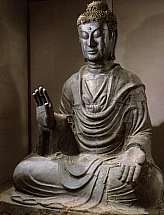
(L) Shaka Triad at Hōryūji Temple, +623, by Tori Busshi
(R) Asuka Daibutsu at Asuka Dera, +609, by Tori Busshi

TENNE 天衣 or 纏衣. (7th & 8th Centuries)
Preliminary Findings. Scarves of gauze, or ribbon-like strips of narrow and ornamental cloth, found frequently on images of the Tennin 天人 (Sanskrit = Apsaras) -- more commonly known as Angelic Attendants, Celestial Musicians, Divine Fairies, Flying Apsaras, or Flying Celestial Maidens (Jp. = Hiten 飛天). Images of these celestial beings adorn Buddhist artwork throughout Asia. Two important examples are the Flying Apsaras at the Dunhuang 敦煌 Caves in China (dating from the 4th century AD onward) and the 7th to 8th century murals at Hōryūji Temple 法隆寺 in Nara (Japan). In both locations, they are depicted wearing light and floating celestial garments, embellished with scarves of gauze. Says JAANUS: Tenne are long, narrow strips of ornamental cloth, found on images of Bosatsu 菩薩 and Tenbu 天部. The Tenne is draped across the shoulders, and hangs down on both sides of the figure. It is sometimes wound around the loins and over the arms, before dropping down to the pedestal. Many Kannon 観音 statues are shown wearing Tenne, for example the 8th-century standing Jūichimen Kannon 十一面観音 at Shōrinji Temple 聖林寺 in Nara. <end JAANUS quote>
This flowing drapery style also appears in 8th-century statuary of the Japanese Nio 仁王 (see below photos). A 9th-century example with the 11-Headed Kannon is shown below. In later centuries, the same ribbon-like cloth appeared on statuary of the Gods of Wind and Thunder (Fūjin 風神 and Raijin 雷神) and other deities.
Says Bernhard Scheid (in a friendly & casual email exchange): “Perhaps it is wrong to look for one clear-cut symbolism for the ribbon drapery style (e.g. clouds or flying). If you look at the diverse fierce deities at Himalayanart.org (Mahakala, Vajrapani, etc.), the tenne ribbon is a common item. Also, in a volume on Mahakala (Daikoku 大黒天変相) by Iyanaga Nobumi (Hozokan 2002), I found several similar representations of Daikoku or rather Makakara-ten as well as Bishamonten with a ribbon. I wonder whether this is not one of the rare items Bodhisattva (mild mannered Buddhist entities) and Myō-ō (fierce entities) have in common, thus pointing to their fundamental identity as protectors and saviors. Isn't it somewhat contraindicative to the otherwise bold and manly figures of the Myō-ō? By contrast, oni (demons) in Buddhist hell couldn’t be imagined with tenne, could they?” <end message Bernhard Scheid; view Scheid’s German-language web site>

Modern Reproduction of the Flying Apsaras at the
Dunhuang 敦煌 Caves in China (Jp. = Tonkō Caves)
Please visit this side page for more details
and photos on the Apsaras at Dunhuang.

Flying Apsaras (Jp. = Hiten 飛天)
Hōryūji Temple 法隆寺 in Nara, Japan
Mural, 7th to 8th Century, Approx. 136 cm wide
Photo courtesy 日本の美をめぐる, No. 11
 
NIO GUARDIAN. Agyō 阿形 H = 378 cm (open mouthed)
Kongō Rikishi 金剛力士. Clay (sozō 塑像) with paint (saishiki 彩色)
Nara Era, 711 AD (Wadō Period Year 4). Hōryūji Temple 法隆寺 in Nara
NIO GUARDIAN. Ungyō 吽形 H = 375 cm (closed mouth)
Kongō Rikishi 金剛力士. Clay (sozō 塑像) with paint (saishiki 彩色)
Nara Era, 711 AD (Wadō Period Year 4). Hōryūji Temple 法隆寺 in Nara

LATE NARA & EARLY HEIAN PERIODS (8th & 9th Centuries). An intermediate stage in the development of Japanese drapery for Buddhist statuary. During this period came the Rolling Wave (Honpashiki Emon 翻波式衣文) and Rippling Wave (Renpashiki Emon 漣波式衣文) styles. Both aimed to achieve a water-like pattern of regularity by alternating between deep and shallow (or wide and narrow, high and low) folds. Representative examples are shown below.
Rolling Wave Style. Honpashiki Emon 翻波式衣文. Also spelled Hompa-Shiki. Literally the “Rolling Wave Style of Drapery Folds.” A carving style that gained prominence in the Early Heian Period (+794-894). Honpa-shiki featured an alternating series of wide and narrow (or high and low, large and small) folds that flowed down the garment in evenly spaced and regular patterns, like waves breaking on the beach. The style became popular and remained in use into modern times. It has a close cousin, called the Rippling Wave Style. Additionally, the Rolling Wave technique was considered a hallmark feature of the Jogan (Jōgan) Style of Buddhist statuary, so-called because it emerged during the Jōgan Period 貞観 (+794-894). The objective was not to create realistic folds, but rather to achieve a melodious, undulating and rhythmic beauty. Representative examples are the standing Juichimen (Jūichimen) Kannon 十一面観音 statue at Hokkeji Temple 法華寺 in Nara, and the sitting Shaka Nyorai 釈迦如来 statue at Muroji (Muro-o-ji) Temple 室生寺, also in Nara. Both are shown below. Another example can be viewed at the Miho Museum in Japan.

Early Heian Era. Honpa Shiki. Rolling Wave Drapery

Example: Honpashiki Emon 翻波式衣文 Drapery
Standing 11-Headed (Jūichimen) Kannon 十一面観音立像
Wood = (Kaya, Japanese Nutmeg)
Ichiboku Zukuri 一木造 (Single-Block Carving)
H = 100. cm, National Treasure
Mid 9th Century, Hokkeji Temple 法華寺, Nara
Photo Credit: 100 Select Buddha Statues (日本の仏像)


Early Heian Era. Honpa Shiki. Rolling Wave Drapery.

Example: Honpa Shiki Emon 翻波式衣文 Drapery
Sitting Shaka Nyorai, National Treasure
Wood: Cypress (檜, 桧 Hinoki)
Ichiboku Zukuri 一木造 (Single-Block Carving)
H = 106.3 cm, National Treasure
Early Heian Era, Muroji (Muro-o-ji) Temple (室生寺), Nara
Murouji, southeast of Nara, is the only esoteric temple
from this time that was not destroyed by fire.
Photo Credit: Comprehensive Dictionary Japan's Nat’l Treasures

CLOSEUP - same statue as prior two photos

SIDE NOTE ONE. Influence of Central Asia on Japanese Drapery. The Encyclopædia Britannica says this about the Honpashiki Emon 翻波式衣文 style of drapery in Japan: “The folds are cut deeply in a simple measured rhythm, a technique suggestive of the string drapery of the colossal image of the Buddha at Bamian (Bamyan), Afghanistan, which was a focal figure for all pilgrims traveling the Central Asian pilgrimage routes to Bamian and India; the statue was destroyed in 2001 by the Taliban. Holy images done in this style were carried back by pilgrims to China and Japan and became prototypes for sacred images carved there. Japan’s Jogan style (Jōgan Period 貞観 +794-894) of drapery is actually an intermediate stage in the development of this mannerism. Alternating series of small and large waves compose the folds of the drapery.

Buddha at Bamian (Bamyan), Afghanistan
Photo Courtesy This Web Site
SIDE NOTE TWO. Robe styles in Japan did not develop independently or in a vacuum. Indeed, a look at two old statues, one from India from the 1st or 2nd century, and another that arrived in Japan from India around +552, clearly show the influence of India and Central Asia on Japanese styles.
|

Buddha
Greco-Buddhist Style
+1st or 2nd Century
Gandhara
(Modern Pakistan)
At the Tokyo National Museum
|

Amida Triad, +552, 善光寺の阿弥陀三尊
Ikko Sanzon Amida 一光三尊阿弥陀
This triad is the main devotional object
at Zenkoji (Zenkōji) Temple 善光寺 in Nagano Prefecture.
It reportedly was made in India, then traveled to China, and
was brought to Japan by Hata no Kosedayuu 秦巨勢大夫 in +552.
|
|

Rippling Wave Style, Renpashiki Emon 漣波式衣文. Also spelled Rempa-Shiki. Literally the "Rippling Wave Style of Drapery Folds." It appeared in the early-to-mid Heian era, with some saying it represents the fancier version of the Honpashiki Rolling Wave style. The Rippling Wave style comes in two basic types: (1) a regular alternating pattern of two low-ridged curves followed by one high curve or as (2) an unbroken series of narrow and low curves.

Mid-Heian Era. Renpa Shiki. Rippling Wave Drapery.

Example: Rempashiki 漣波式 Drapery
Standing Shaka Nyorai 釈迦如来
Wood = (Kaya, Japanese Nutmeg)
Ichiboku Zukuri 一木造 (Single-Block Carving)
H 238.0 cm, National Treasure
Early Heian Era, Muroji (Muro-o-ji) Temple (室生寺), Nara
Murouji, southeast of Nara, is the only esoteric temple
from this time that was not destroyed by fire.
Photo Credit: 100 Select Buddha Statues (日本の仏像)

MID-TO-LATE HEIAN PERIOD (Around +1052). During this time, the acclaimed sculptor Jocho 定朝 (Jōchō) perfected a drapery style that employed wide and shallow folds running in parallel lines. Jocho’s extant Amida Nyorai 阿弥陀如来 statue at Byodoin Temple (Byōdōin) 平等院, and its drapery, have been copied endlessly since then.
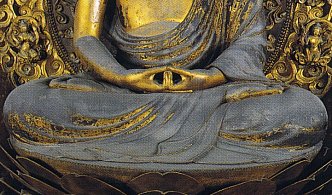
Drapery on Jocho’s extant statue of Amida
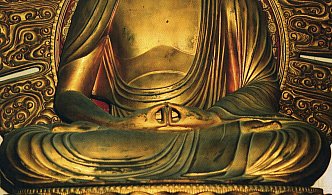
Drapery of mid-Heian Era. Copy of Jocho’s Amida statue.

Drapery of mid-Heian Era. Copy of Jocho’s Amida statue.

Amida Nyorai at Byodoin Temple, Nara
Jocho’s only extant statue. Dated +1052.
Photo Credit: Comprehensive Dictionary Japan's Nat’l Treasures

KAMAKURA PERIOD (12th, 13th, & 14th Centuries). The Kamakura period introduced a number of innovations, including realistic folds in the manner of the period’s great master sculptor Unkei, irregular folds influenced by Sung China and mastered by Unkei’s colleague Kaikei, and exceptionally deep drapery folds called Domon made with clay molds.

Kamakura Period, Unkei-type Realistic Drapery
Big Buddha of Kamakura (Amida Nyorai)
Kamakura Period, Bronze, Dated +1252
Kotokuin (Kōtokuin) 高徳院 in Kamakura
Roughly 15 meters in height

Kamakura Period, Deep Expressive Drapery (by Kaikei Busshi)
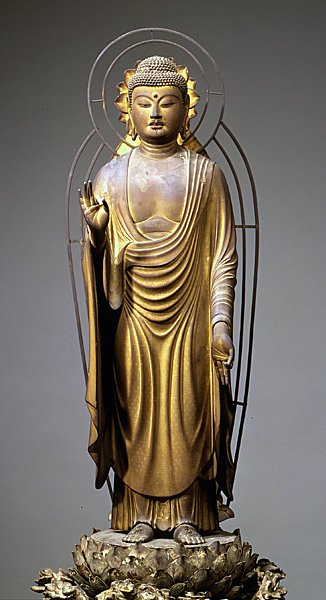
Amida Nyorai 阿弥陀如来 by Kaikei 快慶
Painted Wood, H 100 cm, Dated +1202
Todaiji Temple (Tōdaiji 東大寺), Nara 奈良
Photo courtesy Nara Nat’l Museum.

Kamakura Period, Deep Expressive Drapery (Zen’en Busshi)
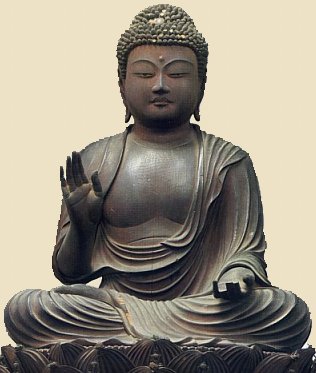
Shaka Nyorai 釈迦如来 (Historical Buddha) by Zen’en Busshi
Dated +1225, Wood, H = 29.0 cm
Treasure of Todaiji Temple, Nara
Photo Credit: Catalog, Exhibition of Todaiji Treasures, 1980

Domon 土紋. Less commonly written 土文. Decorative drapery made from clay. This method of ornamentation appeared in the late 13th century and is unique to the Kamakura area. It featured exceptionally deep drapery folds made with clay molds, or clay decorative elements in the shape of crests, flowers, and leaves. The finished clay relief was then affixed to the statue, often using lacquer.

Above Photo, Below Photo. The Nyoirin Kannon 如意輪観音 statue at Raikoji (Raikōji) Temple 来迎寺 in Kamakura features a beautiful "domon" 土紋, or clay crest. The domon technique was used for decorating Buddhist statues and is unique to Kamakura, and is thus also known as Kamakura Domon 鎌倉土紋. Clay is kneaded 練 (neru) into patterns or placed in molds and then affixed to the statue with lacquer, resembling a relief. The crests on this statue are said to ward off evil (厄除け yakuyoke) and to ensure easy delivery (安産 anzan) to women in labor. Statue dated to 14th century.
Legend About This Statue: A sad story about the Nyoirin Kannon tells about a man in Yui (由比), who was living a luxurious life, with not a care in the world. The man had a daughter he loved very much, but one day a large eagle swooped down and carried her off. The father frantically searched for his daughter, and although he eventually found her, she was dead. He interred her remains inside the body of this Nyoirin Kannon for the repose of her soul. <legend quoted from the Kamakura Citizens Net, as told by the temple>

EXTANT EXAMPLES OF DOMON
Technique unique to Kamakura, emerging in the late 13th century
- Denshu-an (Denshūan), a sub-temple of Engakuji Temple 円覚寺. Wood statue of Jizo (Jizō) Bosatsu 地蔵菩薩像 with domon drapery, dated to the Kamakura period. Located in Kita Kamakura.
- Hokaiji (Hōkaiji) Temple 宝戒寺, Kankiten 歓喜天; a Hidden Buddha 秘仏 (hibutsu) not shown to the public; wood, domon drapery, approx. 155 cm in height; dated to late Kamakura period; said to be the oldest statue of Kankiten in Japan; located in Kamakura city.
- Jochiji (Jōchiji) Temple 浄智寺, Idaten 韋駄天, Wood statue with domon drapery, Muromachi period, although head and hands remade in Edo period, now housed at the Kamakura Kokuhoukan (Kamakura Museum) 鎌倉国宝館 in Kamakura city.
- Jokomyoji (Jōkōmyōji) Temple 浄光明寺, Wood, Amida Triad 阿弥陀三尊, with domon drapery on central Amida 阿弥陀如来 statue; dated to Kamakura period. Located in Kamakura City. Considered to be the oldest extant example of the domon technique featuring exceptionally deep drapery folds; dated to +1299.
- Kakuonji Temple 覚園寺, Amida Nyorai 阿弥陀如 statue, also known as Saya Amida (鞘阿弥陀), for inside the statue was found another small Buddha statue; the term "saya" means sheath or case, and thus the large statue became known as Saya Amida; wood statue with domon drapery, although the domon patterns are no longer clear; dated to Kamakura period; located in Kamakura city.
- Kamakura Kokuhoukan (Kamakura Museum) 鎌倉国宝館; domon fragments in its collection; museum located on grounds of Tsurugaoka Hachimanguu Shrine 鶴岡八幡宮, in Kamakura City. Other domon fragments in collections of private individuals.
- Raikoji (Raikouji) Temple 来迎寺, Nyoirin Kannon 如意輪観音像, Wood with domon crests (see photos above). Dated to Nanbokuchō Period 南北朝時代. Located in Kamakura city.
- Tokeiji (Tōkeiji) Temple 東慶寺, Sho (Shō) Kannon 聖観音, Wood statue with domon drapery; Dated to late Kamakura period. Located in Kita Kamakura.

Hōesuikashiki (Hoesuikashiki) 法衣垂下式. Lit. “Hanging Vestment Style.” This style rose to great prominence in Kamakura and surrounding Kanto region in the late-Kamakura era & Nanbokuchō Period. It reflects the tastes of Sung-era China.

Shaka Nyorai (Historical Buddha) at Hōkokuji (Hokokuji) Temple 報国時 in Kamakura.
Wood, H = 50.6 cm. Central image of worship at this temple. Nanbokuchō Period 南北朝時代 +1336-1392.
This style of pendant drapery is called the “hanging vestment style” (hōesuikashiki 法衣垂下式), which rose
to great prominence in Kamakura and the Kanto region in the late-Kamakura era and Nanbokuchō Period.

Robes Worn by Monks
Brief History and Terminology
Robe, Vestment, Surplice, Garment.
|
Other Terms for Robe
Noe, Nōe, Noue
衲衣 or 納衣
Shinnoe, Shinnōe, Shinnoue
刺納衣 or 刺衲衣
Nogesa, Nōgesa, Nougesa
衲袈裟
No, Nō, Nou
衲
|
|
 Kesa 袈裟. Also called “Okesa.” A Buddhist robe or surplice. A general term referring to all robes, including those depicted on Buddhist statues and those worn by monks. Buddhism originated in India, and so too did the robe. The Japanese term Kesa was derived from the Sanskrit word Kasaya (lit. “dark colored”), for in early India, the monks always donned robes of dyed cloth while the lay folk wore white. The Kesa was (is) traditionally made by the aspiring acolyte, nun, or monk by stitching together rags and the discarded clothes of lay people (Funzoe, Funzō-e, 糞掃衣). In India, where temperatures are hot, monks needed only one outer garment. But in Japan and China, where temperatures got much colder, other garments were needed and worn underneath the Kesa. Thus, in Japan and China, the term “Kesa” refers generally to the outermost robe, which became a symbol of faith, an ornament, one not really needed for protection against the elements. In later times, in Japan, fine fabrics were used to make the Kesa. These included Kinran 金襴 (gold brocade) and Nishiki 錦 (patterned weave fabrics). Robes made with such fine fabrics featured narrow strips of cloth, sewn together, distinguished by the number of strips. The Gojogesa (Gojōgesa) 五条袈裟 had five strips, the Shichijougesa (Shichijōgesa) 七条袈裟 seven strips, etc. Over time, Japan’s many Buddhist sects developed their own distinctive Kesa styles. The Zen sect, for example, developed the Rakusu 絡子 robe, a shoulder-worn ornamental robe employing an attachment ring. Kesa 袈裟. Also called “Okesa.” A Buddhist robe or surplice. A general term referring to all robes, including those depicted on Buddhist statues and those worn by monks. Buddhism originated in India, and so too did the robe. The Japanese term Kesa was derived from the Sanskrit word Kasaya (lit. “dark colored”), for in early India, the monks always donned robes of dyed cloth while the lay folk wore white. The Kesa was (is) traditionally made by the aspiring acolyte, nun, or monk by stitching together rags and the discarded clothes of lay people (Funzoe, Funzō-e, 糞掃衣). In India, where temperatures are hot, monks needed only one outer garment. But in Japan and China, where temperatures got much colder, other garments were needed and worn underneath the Kesa. Thus, in Japan and China, the term “Kesa” refers generally to the outermost robe, which became a symbol of faith, an ornament, one not really needed for protection against the elements. In later times, in Japan, fine fabrics were used to make the Kesa. These included Kinran 金襴 (gold brocade) and Nishiki 錦 (patterned weave fabrics). Robes made with such fine fabrics featured narrow strips of cloth, sewn together, distinguished by the number of strips. The Gojogesa (Gojōgesa) 五条袈裟 had five strips, the Shichijougesa (Shichijōgesa) 七条袈裟 seven strips, etc. Over time, Japan’s many Buddhist sects developed their own distinctive Kesa styles. The Zen sect, for example, developed the Rakusu 絡子 robe, a shoulder-worn ornamental robe employing an attachment ring.
Funzo-e (Funzō-e, Funzoue) 糞掃衣. Robe made from rags and discarded clothing. According to Buddhist tradition, aspiring acolytes, nuns, and monks were to make their own robes from rags and the discarded clothing of lay people. Such rags were found, washed, and then sewn together in patchwork form. Japan’s oldest robe, made in this style, is dated around the 7th or 8th century, and is found at Hōryūji Kennō Hōmotsu 法隆寺献納宝物 in Nara. There are ten types of rags, according to Shunryū Suzuki Rōshi (+1904 to 1971), the Japanese Zen master who founded the San Francisco Zen Center in 1962 and encouraged the teaching of robe-sewing techniques and the giving of the Buddhist precepts to both the monastic and lay communities.
Ten Types of Rags & Discarded Clothing
- Chewed on by an ox
- Scorched by fire
- Soiled by childbirth
- Left at a graveyard
- Discarded by a king’s officers
- Gnawed by rats
- Soiled by menstruation
- Offered at a shrine
- Offered in petitional prayer
- Brought back from a Funeral
Source: Verbatim transcript, “Lecture During Sewing Sesshin,” given on June 6, 1971. Lecture Archives, San Francisco Zen Center. This list also appears in the booklet Buddha’s Robe is Sewn, by Jean Selkirk. The booklet is available at BuddhasRobeIsSewn.org

Rules for Robes and Wearing Robes
Based on Buddhist law, monks were forbidden to wear robes using any single primary color (there are five, called the Goshiki 五色). But this was permitted, in Japan, if the robe’s fabrics were made of patchwork pieces from various rags and discarded clothing (Funzoe 糞掃衣). Robes made with five fabrics of different color are called Gonoe 五衲衣 (Gonōe). Robes made from many more colors are called Hyakunoue 百衲衣 (Hyakunōe), literally “100-colored robe.”
- Tsuken (Tsūken) 通肩 or Tsuryo Kenpo (Tsūryō Kenpō) 通両肩法. A type of robe found on statues of the Nyorai (Buddha, Tathagata 如来) that covers both shoulders, with concentric folds falling down from the neck, chest, and stomach. Typically, but not always, the left hand holds one end of the robe, which is draped below the left arm. The Tsuken style is more common in China and India, where monks wore a formal robe called the Sogyari (Sōgyari) 僧伽梨 for visits outside their temples.
- Hentan Uken 偏袒右肩. A type of robe found on Nyorai (Buddha, Tathagata 如来) that leaves the right shoulder exposed. This custom derived, it is said, from an Indian tradition wherein monks showed respect by slipping the robe off their right shoulder.
- Sanne 三衣. According to Buddhist tradition, each monk could keep only three robes. If worn one over the other, this was enough to stay warm on the coldest nights.
- Sogyari (Sōgyari) 僧伽梨 or 大衣 (Skt. = Sanghati)
Used for excursions outside the temple.
- Uttarasou (Uttarasō) 鬱多羅僧 (Skt. = Uttarasanga)
Used for worship
- Andae 安陀衣 (Skt = Antarvasaka)
Used for work and sleeping

Common Types of Robe & Surplice
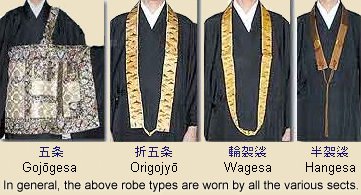
Photos courtesy this J-Site

- Gonoe 五衲衣 (Gonōe). Robes made with five fabrics of different color.
- Gojogesa 五条袈裟 (Gojōgesa) has five strips. See photo above.
- Hangesa 半袈裟. Half surplice. See photo above.
- Hyakunoue 百衲衣 (Hyakunōe), literally “100-colored" robe.
- Igiboso 威儀細. Used by the Pure Land Sect (Jodo 浄土), similar in appearance to an apron. See photo above.
- Jyujigesa 呪字袈裟. Incantation Robe. The robe may also contain a magical incantation or spell or "curse word" to ward off evil, sickness, etc. (呪 = Noroi = curse while 字 = JI = word)
- Origojyou 折五条 (Origojyō). Also known as the Tatamigesa 畳袈裟た. See photo above.
- Rakusu 絡子. Special to the Zen (禅) denomination. Similar to the Igiboso, but employs a ring. See photo above.
- Sa 裟. Japanese term for Buddhist surplice. Most sects have their own individual crest which appears on the surplice. See table below. Surplices can be bought online at this J-Site.
|

|

|

|

|
|
Shingon
Koyasan
|
Shingon
Buzanha
|
Shingon
Chisanha
|
Tendai
Sect
|
|
|

|

|

|

|

|
|
Jodo
1
|
Jodo
2
|
Jodo
Honganji
|
Jodo
Shinshu
|
Zen
Soto
|
|
- Shichijougesa 七条袈裟 (Shichijōgesa) has seven strips.
- Shujigesa 種子袈裟. Seed-Syllable Robe. Among the Tendai (天台) and Shingon (真言) sects of Esoteric Buddhism, the robe is sometimes sewn with the seed syllable (Shuji 種子) of the Buddhist deity.
- Wagesa 輪袈裟. Round surplice. See photo above.
- Yuigesa 結袈裟. Has nine strips. Especially important to the Shugendo 修験道, a syncretic religious order of mountain worshippers. Variation of this robe type used by Tendai sect; its most common form known as the Bonten Kesa 梵天袈裟. Variation also used by Shingon sect; its most common form known as Shutaragesa 修多羅袈裟. See photo above.

JAPANESE RESOURCES
ENGLISH RESOURCES

First Published August 2007. Last Update Oct. 2009.
|
|